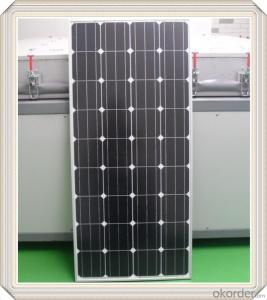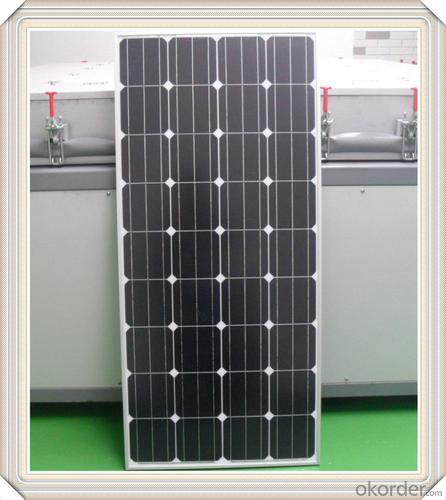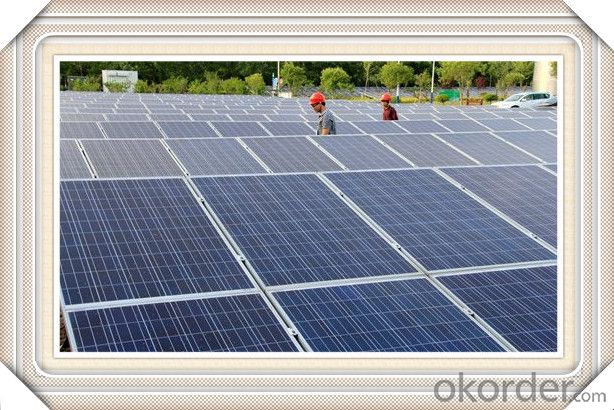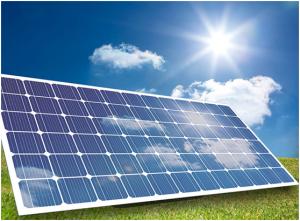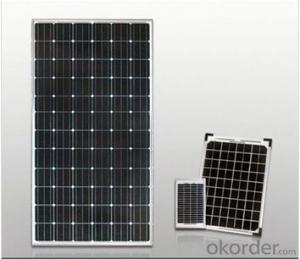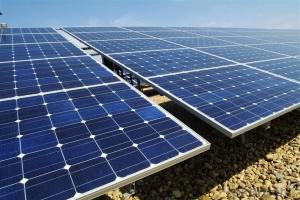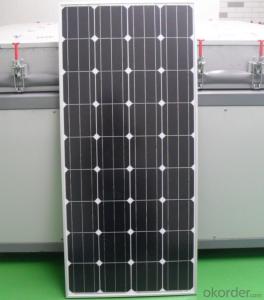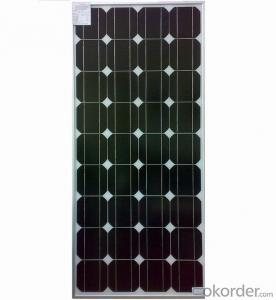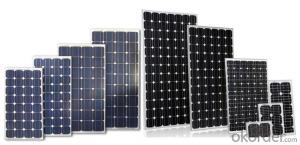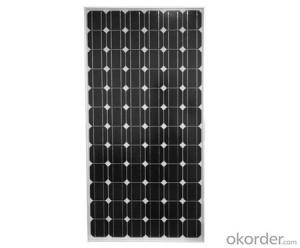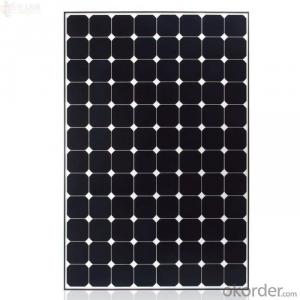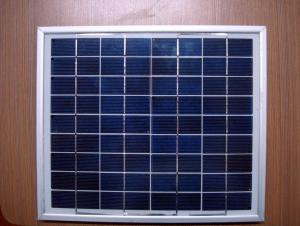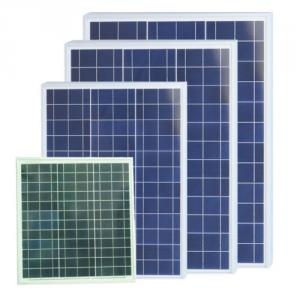Sec Solar Panels 270watt CNBM Solar Mono晶Silicon Series (250w—270w)
- Loading Port:
- China main port
- Payment Terms:
- TT OR LC
- Min Order Qty:
- 100000 watt
- Supply Capability:
- 500000 watt/month
OKorder Service Pledge
OKorder Financial Service
You Might Also Like
Specification
CNBM Solar Monocrystalline Series III (250W—260W)


Characteristics
Max Power Voltage Vmp(V) | 30.1 | 30.2 | 30.4 | ||
Max Power Current Imp(A) | 8.32 | 8.44 | 8.55 | ||
Open Circuit Voltage Voc(V) | 37.5 | 37.6 | 37.7 | ||
Short Circuit Current Isc(A) | 8.87 | 8.99 | 9.10 | ||
Max Power Pm(W) | 250 | 255 | 260/265 | ||
Temperature Coefficient of Cells
NOCT | 45℃±2℃ | |
Temperature Coefficients of Isc (%/℃) | - 0.0492 | |
Temperature Coefficients of Voc (%/℃) | – 0.3374 | |
Temperature Coefficients of Pmp (%/℃) | –0.4677 | |
Mechanical Data
Dimension | 1638 x 982 x 40 mm | |
Weight | 19.5kg | |
No. of Cells and Connections | 60 (6 x 10) | |
Tolerance | 0~+5W | |
Cell Monocrystalline Cell | 156 x 156 mm | |
Packing | 700 Pcs/40ft(H) Container | |
Limits
Operating Temperature | –40 °C to +85°C | |
Storage Temperature | –40 °C to +85°C | |
Max System Voltage | 1000VDC(IEC) / 600VDC(UL) | |
IV Curve
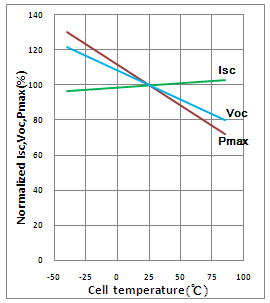
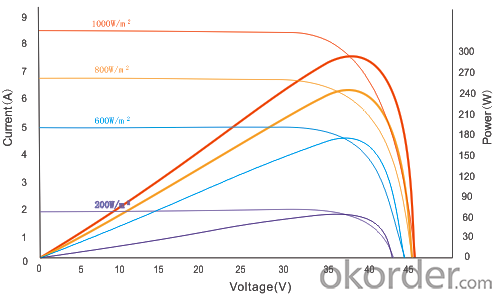
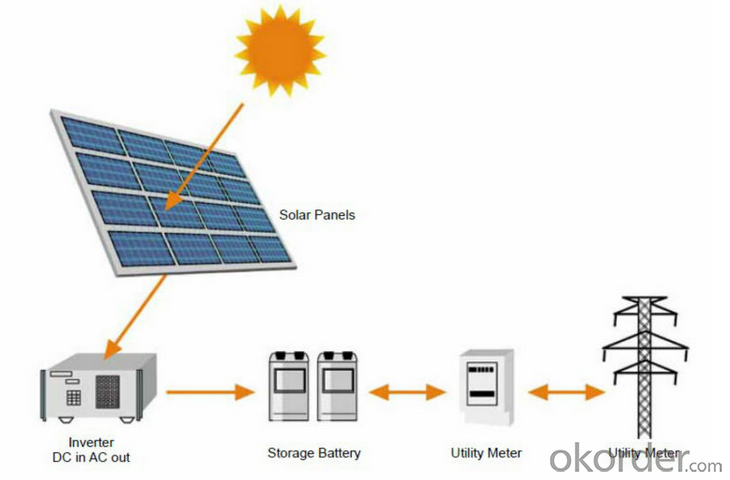
Image
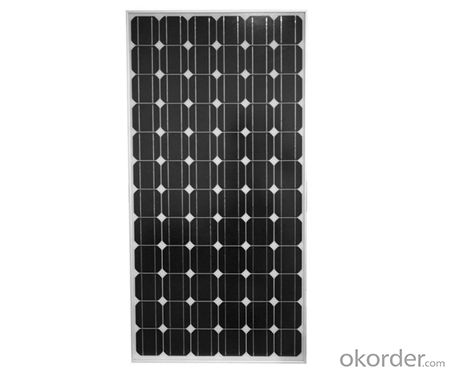
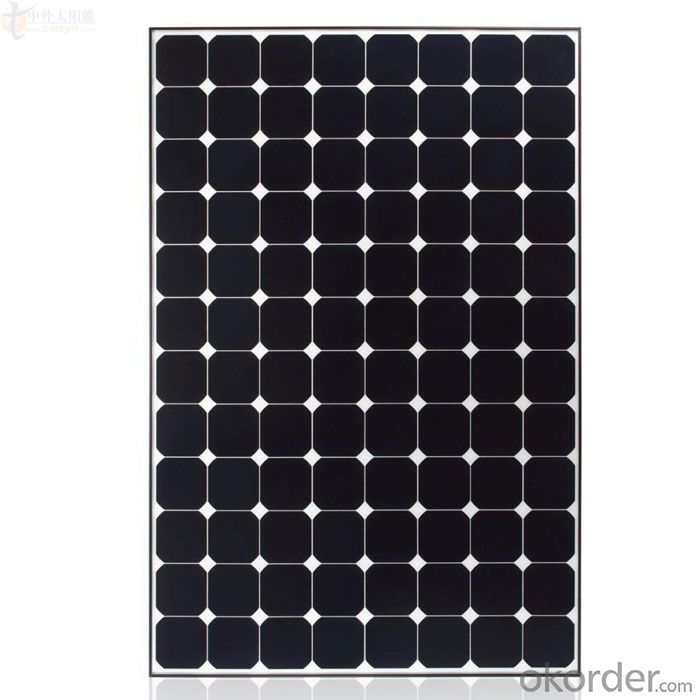
Guarantees
Products Guarantee 12 yrs free from defects in materials and workmanship
Performance Guarantee No less than 90% within 10yrs and no less than 80% within 25yrs
Certificates TUV (IEC61215&IEC61730), VDE(IEC61215&IEC61730), UL, CE
FAQ
1. Q: Do you have your own factory?
A: Yes, we have. Our factory located in Jiangsu province.
2. Q: How can I visit your factory?
A: Before you take off from your country, please let us know. We will show you the way, or arrange time to pick you up if possible.
3. Q: Do you provide free sample?
A: Usually we do not offer free sample
4. Q: Could you print our company LOGO on the nameplate and package?
A: Yes, we can do that.
- Q: I have two solar panels that were going to be trashed at work. I want to use them to charge batteries on my RV but i noticed they put out around 20 volts in direct sunlight. So i am wondering: -isn't this way too much voltage for a 2 volt system? -do a need some sort of a regulator connected to keep them from overcharging?
- 20 volts is a common open-circuit voltage for nominal 2v panels. The panels put out about 5v at full load. If the panel puts out little enough that it takes 20 hours or more to put a full charge in the battery you can get by without a charge controller - just keep the cells topped up with distilled water. A charge controller will do a more efficient job, though. The most efficient charge controllers use what's called Maximum Power Point Technology (MPPT) which lets the panels operate at their most efficient point throughout the battery's charging cycle. Available on OKorder. The charge controller should have the same or higher wattage as the panels it controls - if you're not sure of wattage, assume that they are the same as similar area panels you find for sale. Before buying a charge controller, connect the panels through an ammeter to a discharged battery. They may have been trashed because of damage and low output. You need at least an amp for trickle charge, 5 amps for reasonable recharge times.
- Q: Can solar panels be installed in a desert environment?
- Yes, solar panels can be installed in a desert environment. In fact, desert regions are highly suitable for solar energy generation due to their high levels of sunlight and low cloud cover. The dry and arid conditions in deserts also help in reducing the maintenance and cleaning requirements of solar panels.
- Q: i am wanting to build a small tiny house running 3-4 2 volt 5 watt light bulbs for a lighting source and using a Koolatron Fun Kool 26 Quart 2V Portable Mini Fridge This cooler consumes 4.5 amps at 2 volts. The conversion is: 4.5 amps (X) times 2 volts (=) equals 54 watts. and i want a solar system that will have back up for 2 days with the lights on for probly 5-6 hours a day so theirs no room for error
- you silly ! with Solar there is always room for error . you have to build it in to your numbers . solar is full of errors . So you should plan on producing at 3 times what you expect you will need . then you have enough .
- Q: Can solar panels be installed on a military vehicle or equipment?
- Yes, solar panels can be installed on military vehicles or equipment. In fact, several military forces around the world have already started incorporating solar panels onto their vehicles and equipment as a means of reducing reliance on traditional fuel sources and enhancing energy efficiency. This not only helps reduce carbon emissions but also provides a sustainable and reliable source of power for various operations and equipment on the field.
- Q: Can solar panels be installed on hospitals or healthcare facilities?
- Yes, solar panels can definitely be installed on hospitals or healthcare facilities. In fact, many hospitals and healthcare facilities around the world have already embraced solar energy as a sustainable and cost-effective solution. Solar panels provide a reliable source of clean energy, helping these facilities reduce their carbon footprint and dependence on traditional energy sources. Additionally, solar power can contribute to long-term cost savings, allowing hospitals to allocate more resources towards patient care and medical services.
- Q: Can solar panels be installed on art installations or sculptures?
- Yes, solar panels can be installed on art installations or sculptures. This allows them to generate electricity from sunlight, effectively integrating renewable energy into artistic designs.
- Q: Can solar panels be installed on a convention center or event venue?
- Yes, solar panels can be installed on a convention center or event venue. In fact, many convention centers and event venues are increasingly adopting solar energy solutions to reduce their carbon footprint and lower energy costs. The large roof spaces available in these venues often make them ideal for solar panel installations, allowing them to generate clean and renewable energy.
- Q: Can solar panels be used in multi-story buildings?
- Yes, solar panels can be used in multi-story buildings. They can be installed on rooftops or other suitable areas to generate renewable energy for the building.
- Q: a fiber optic network could distribute solar energy from warm states to the rest of the country. Using a Federally created program,the energy would be used through a trust program to benefit all of our citizens equally. It would create thousands of jobs and help us with our dependence on foriegn oil supplies. This is no different than work programs created by the Feds during the 930's depression era.
- As a matter of fact these types of facilities are being built today. People are already hard at work on it. Yes solar is more expensive that conventional electricity sources, but only at first. A solar power plant has no fuel costs and so although it costs a lot more to build at first over its life time it can actually cost a lot less. That doesn't even count the costs of byproducts from conventional power plants. Most people are not aware that particulate pollution kills between 00,000 and 200,000 people in the United States every year. The majority source of particulate pollution is electrical power production, but our electrical bill does not include the costs of those deaths. If the electric utilities had to pay their fair share of those medical costs electricity produced by fossil fuels would look a lot less attractive. Some people think solar panels take more energy to build than they every collect from the sun but that is not true. A solar panel generates the energy it takes to make it in between and 2 years and after that the power it generates is basically free. Solar panels are expected to last between 30 and 50 years, so that is a lot of free power. By the way, I installed solar panels on my house. They cost me about 6000 dollars (after rebates and tax deductions) and saves me about 000 dollars every year from my electrical bill. I have a 5 bedroom house and a family of three and our electrical bill averages just $35/month. That is in California with some of the highest electrical rates in the country. So I can say that solar works. There are dozens of companies working very hard to make solar power more affordable and they are being successful. The solar industry is about 7X larger in 2006 than it was in 2000. It is one of the fastest growing industries and has sustained growth of 40% per year for the last five years. Solar power will become the largest industry on Earth, but it will take some time. It is a very encouraging development.
- Q: How much would it cost to make an average size house be able to depend on solar panels for all of its power?How many solar panels would you need and wear would you put them? Would the roof be large enough to support the panels needed?Do solar panels work well in higher latitudes like northern USA or southern Canada? Can you power your house for the whole year if you live in these environments? What kind of maintenance do solar panels require?
- In the US, the average electricity consumption for a house is 958 kwh per month which is 32 kwh per day for a 30 day month. Once you get to New York City, the number of hours of usable sunlight drops to four hours per day so using six hours a day as a guideline and the fact that inverters tend to be 65% efficient, you wind up requiring 8.205 kw of solar panels which at $5 a watt amounts to $4,205 not including the inverter. Your first task would be to reduce your energy use. Keep in mind that the effective cost of solar power in 2007 was 38 cents per kwh. Without government incentives, you wind up paying more for your electricity than had you just bought it from the grid.
Send your message to us
Sec Solar Panels 270watt CNBM Solar Mono晶Silicon Series (250w—270w)
- Loading Port:
- China main port
- Payment Terms:
- TT OR LC
- Min Order Qty:
- 100000 watt
- Supply Capability:
- 500000 watt/month
OKorder Service Pledge
OKorder Financial Service
Similar products
Hot products
Hot Searches
Related keywords
